Dolan vs Manhattan Josephson junctions
Multi-angle shadow evaporation is the de facto method employed to fabricate Josephson junctions (JJs). Two shadowing mechanisms are standard: Dolan-bridge junctions use a suspended resist bridge whereas Manhattan-style junctions rely on the resist height. In this work, we perform a multi-wafer study comparing uniformity and yield of the two JJ variants on NbTiN-metallized wafers, both planar as well as via-integrated ones. To learn more about the insights gleaned from this study, please check out our paper here!
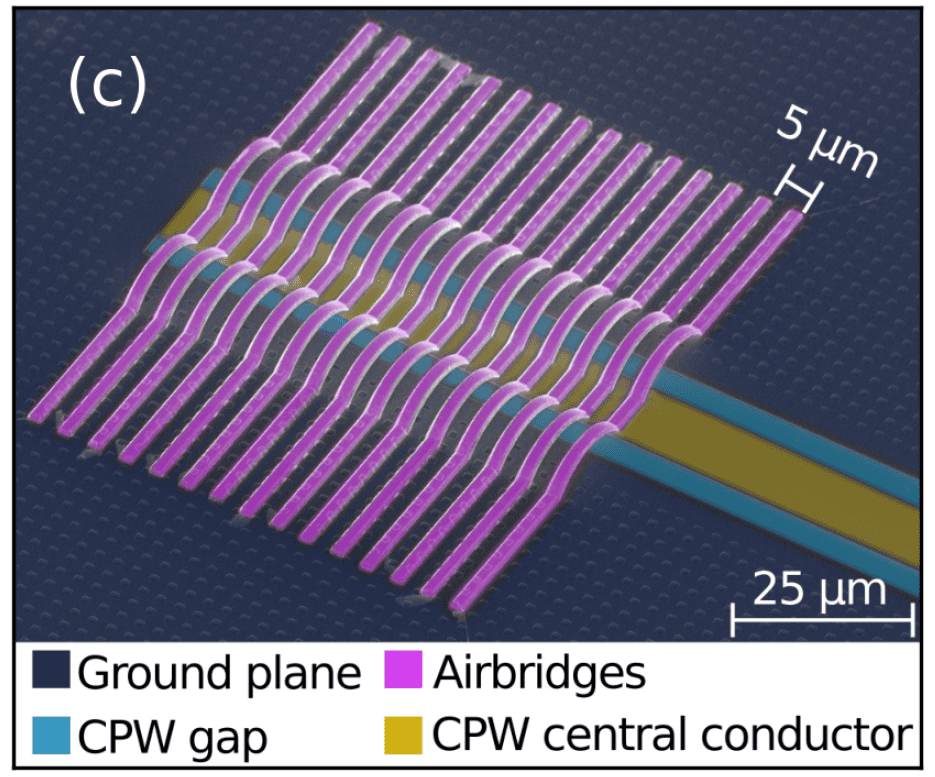
Shoelacing: post-fabrication frequency trimming for resonators
Accurate targeting of qubit and resonator frequencies is increasingly important as circuit QED processors grow. In this work, we introduce a technique allowing the post-fabrication frequency trimming of resonators used for qubit readout. Shoelacing, as we call it, can be used to: eliminate frequency crowding between resonators used to readout different qubits with a common feedline; and to frequency match readout resonators and Purcell filters. We use shoelacing in combination with transmon laser annealing to achieve fast, high-fidelity readout on all qubits of our Surface-17 quantum processor, showcasing its reliability.
To learn more about the nickname, we invite you to check out our manuscript here!
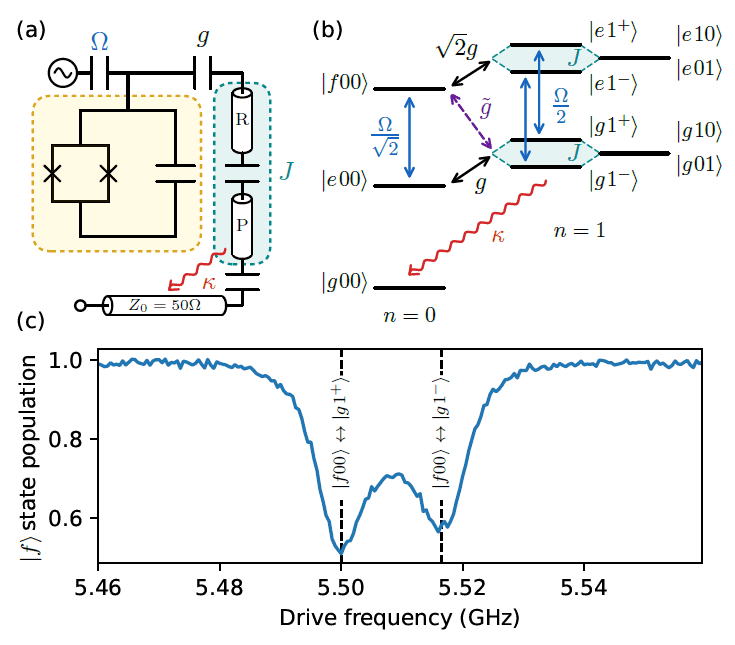
Leakage reduction units implemented
Transmon leakage from the computational subspace is a major obstacle (a headache!) for quantum error correction using codes such as surface code, which are designed to correct errors only within the computational subspace. We have implemented and extended the leakage reduction units (LRUs) proposed by our colleagues in the Terhal group [F. Battistel et al., PRX, 2, 030314 (2021)]. These LRUs induce seepage from leaked transmon states to the computational subspace using all-microwave pulses and only quantum hardware already available in our processors. We demonstrate the power of these LRUs in a building-bloc QEC experiment. Please check out our paper for more information!
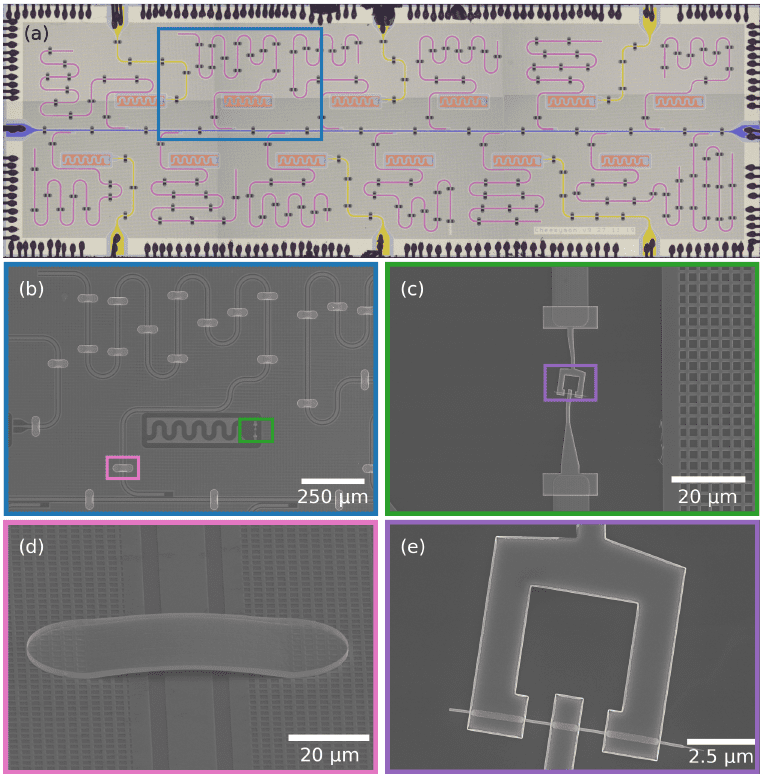
Airbridge fabrication at reduced temperature increases yield of SNS transmons
We present a method for fabricating superconducting airbridges using grayscale lithography. The key advantage over conventional methods relying on resist reflow is the reduction in peak fabrication temperature from 200 to 150 degC. This change significantly increases the yield of operable transmons based on superconductor-normal-superconductor Josephson junctions. We invite you to learn all the details here!

Logical-qubit operations in Surface-7
We demonstrate a complete suite of logical-qubit operations for the distance-2 surface code, aka Surface-7, capable of quantum error detection. Our logical operations span arbitrary initialization on the logical Bloch sphere, measurement in all cardinal bases, and a universal set of single-logical-qubit gates. For each operation type, we quantify the increased performance of fault-tolerant variants over non-fault-tolerant ones. Please check out our manuscript for all the details!
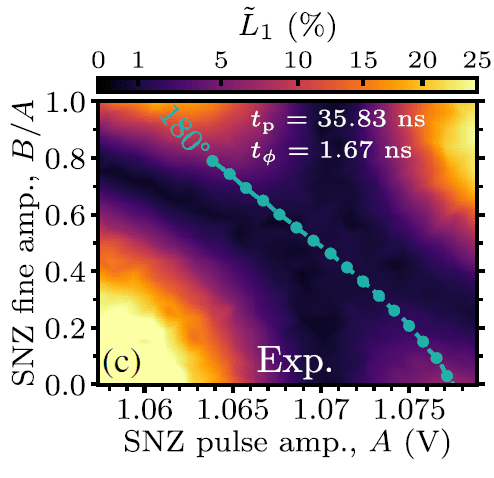
The Sudden Net-Zero CZ gate
We introduce the sudden variant of the Net-Zero scheme implementing two-qubit CZ gates. Sudden Net-Zero (SNZ) offers two advantages while preserving the built-in echo, destructive leakage interference, and repeatability characteristic of conventional NZ. First, SNZ operates at the speed limit of transverse coupling by maximizing intermediate leakage to a non-computational state. The second advantage is greatly simplified tuneup: the landscapes of conditional phase and leakage (see image to the left) as a function of two pulse parameters have regular structure and interrelation, easily understood by analogy to the Mach-Zehnder interferometer. We invite you to learn all the details here!
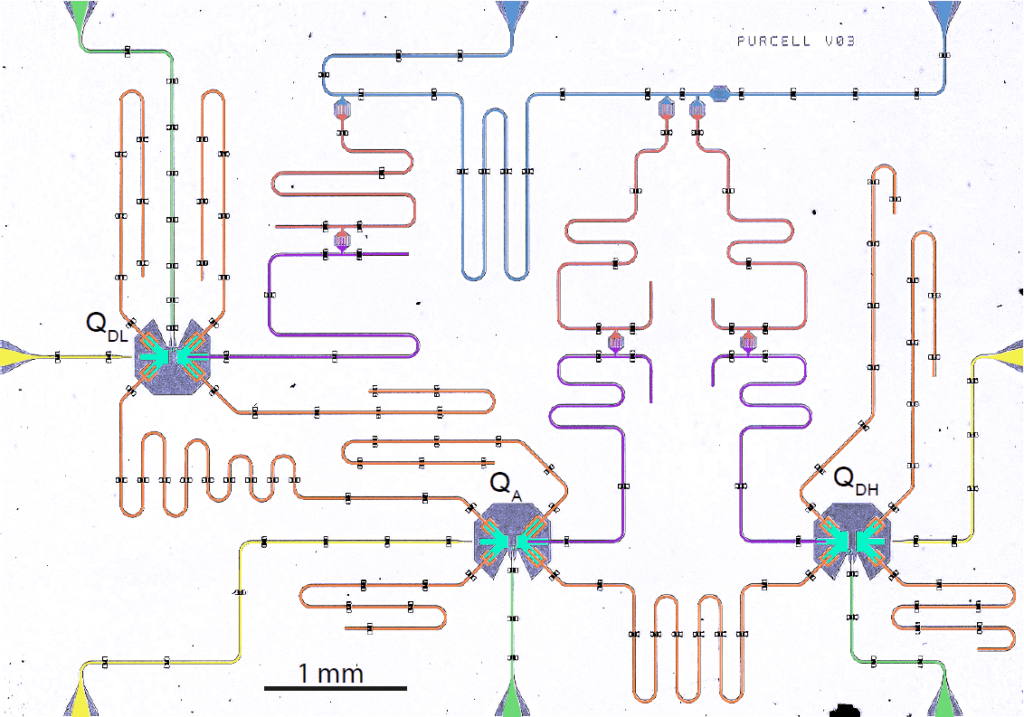
Stabilizing Bell states with Surface-3
We perform stabilization of two-qubit entanglement using repeated parity measurements performed using a third, ancilla qubit. We use hidden Markov models to detect leakage from the string of two-level ancilla outcomes, improving the entanglement by post-selection of inferred leakage events. We invite you to check out our paper here!

The Cryoscope
We have recently developed an in-situ technique we call Cryoscope, which uses a qubit to accurately sample the flux pulses used to dynamically control its frequency. This measurement is key for determining the linear-dynamical distortion on the flux control line and later correcting it, as needed for high-fidelity two-qubit gates. We invite you to check out our manuscript here!
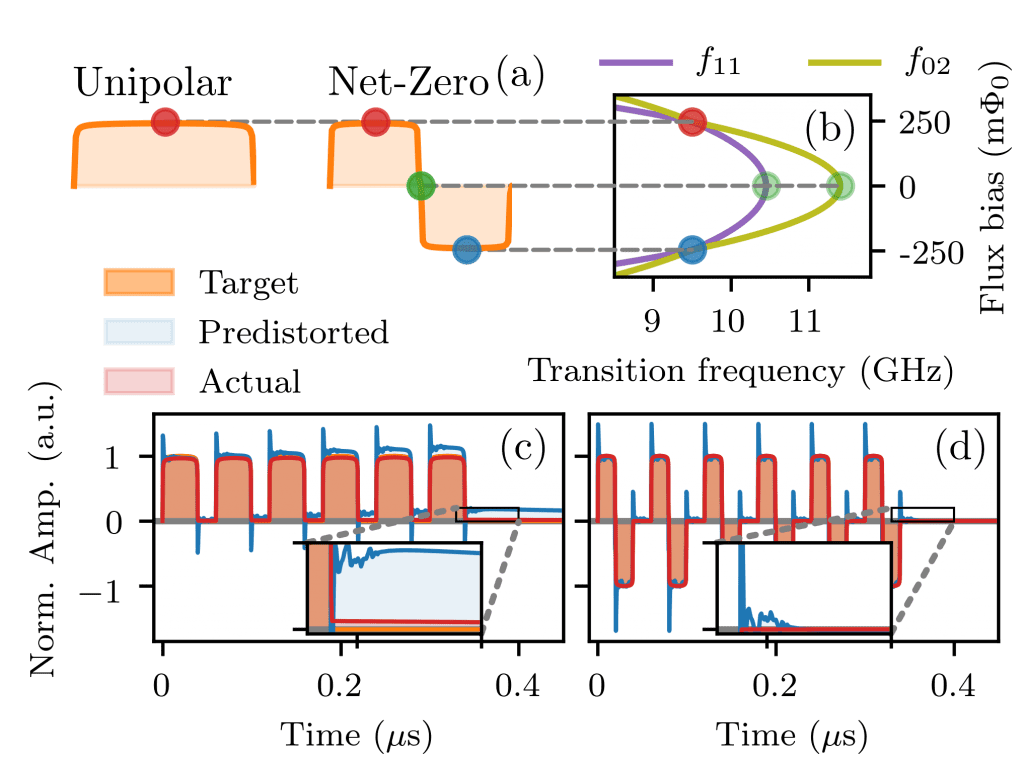
The Net-Zero two-qubit gate
We have recently developed a new type of conditional-phase gate for transmon qubits providing several key improvements over standard flux-pulsing-based versions. The Net-Zero gate uses “leakage interference” to minimize leakage to non-computational states. The zero-average, bipolar shape of the pulse makes the gate robust to long timescale distortions in the flux control line and additionally provides an echo effect. We demonstrate a state-of-the-art conditional-phase gate of duration 40 ns achieving 99.1% fidelity and 0.1% leakage.
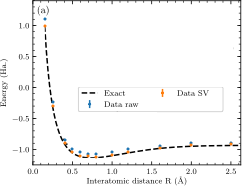
Variational eigensolver with error mitigation
Running accurate algorithms without the need for fully-fledged quantum error correction is a key challenge for quantum computing in the NISQ era. This challenge calls on us to develop techniques that mitigate errors with small overhead .We have recently introduced and demonstrated our own technique for error mitigation, termed symmetry verification, in the context of solving molecular spectra with a quantum processor. In our recent paper, we demonstrate the use SV to reduce the energy error and state infidelity by one order of magnitude in a variational quantum eigensolver for the ground state of the hydrogen molecule.
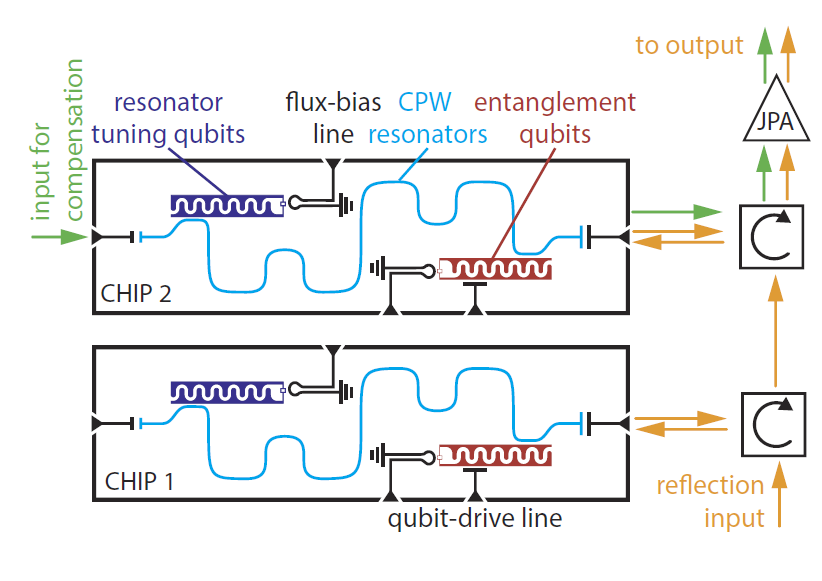
Entangling qubits on separate chips!
While the processing power in circuit QED chips is growing rapidly, it remains an open challenge to establish high-fidelity quantum links between qubits on different chips. We have achieved entanglement between transmon qubits on different cQED chips with 49% concurrence and 73% Bell-state fidelity. We engineer a half-parity measurement by successively reflecting a coherent microwave field from two nearly-identical transmon-resonator systems. By ensuring that the measured output field does not distinguish |01> from |10>, unentangled superposition states are probabilistically projected onto entangled states in the odd-parity subspace. We use in-situ tunability and an additional weakly coupled driving field on the second resonator to overcome imperfect matching due to fabrication variations. Please check out our manuscript here!
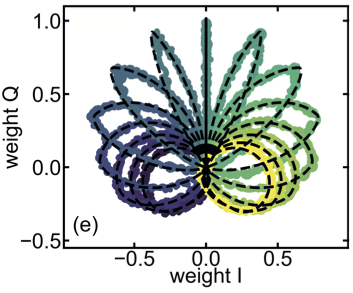
How noisy is my measurement?
When measuring superconducting qubits using dispersive readout, the measurement signal is degraded by noise photons that are added somewhere in the amplification chain. We have developed a method that quantifies this degradation for arbitrary device parameters and readout conditions. So, no matter whether your readout is highly dynamic, your readout frequency is a megahertz off from special symmetry conditions, or your readout pulse looks like a typical Dutch skyline, you will get a consistent answer. We prove the method with a state-of-the-art travelling-wave parametric amplifier and explore to what extent we can approach the noise limit set by quantum mechanics. We invite you to read our manuscript here.

Coherent nanowire-based transmons
For our second-generation nanowire transmon qubits, we used InAs nanowires with an epitaxially grown Al shell, provided by our colleagues in Copenhagen. We etched away a section of this shell to define a superconducting-normal-superconducting (SNS) Josephson junction, giving the transmon its nonlinearity. Combining the hard induced superconducting gap of these wires with our established NbTiN fabrication recipes lead to unprecedented coherence times in SNS devices. This allowed us to study various noise sources affecting the coherence of these qubits. In addition, we showed that the devices can withstand magnetic fields of 80 mT, taking a step towards interesting applications of circuit quantum electrodynamics at field. We invite you to check out our manuscript here!
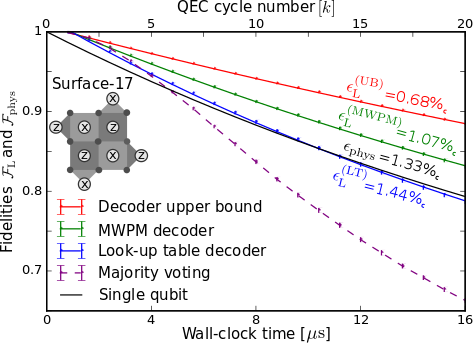
How well will Surface-17 work?
Using our full density-matrix simulator, quantumsim, we have just finished modelling how well our targeted Surface-17 logical qubit will work at the current performance of transmon qubits in planar circuit QED. Our in-depth modelling includes the errors that we care about in experiment, such as qubit relaxation, dephasing from flux noise, dephasing from remnant photons in readout resonators, etc. In short, we do not settle for depolarizing channels here! And here is the good news: at current performance, the small surface code that we pursue should surpass the break-even point of quantum memory, an important first milestone for logical qubit performance. We invite you to read our manuscript here.
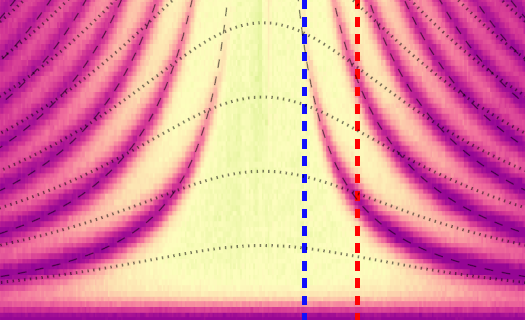
Simulating the quantum Rabi model: atoms and photons at their most intimate
One of the most exciting application areas for future quantum computers is in quantum simulation, the task of using a well-controlled quantum system to mimic the behaviour of another target quantum system. Recently, using a dedicated circuit QED system, we have demonstrated a highly flexible and accurate digital quantum simulation of the quantum Rabi model, a cornerstone of modern quantum physics, in the exotic “deep-strong coupling” parameter regime, where traditional strong-coupling approximations break down. We accurately control dynamical evolution of a coupled qubit-resonator system over a broad range of parameters and demonstrate key dynamical signatures of deep-strong coupling physics. Our demonstration is one of the most advanced digital quantum simulations to date, showing important performance characteristics which have not previously been observed in the solid state. We invite you to read our manuscript here.
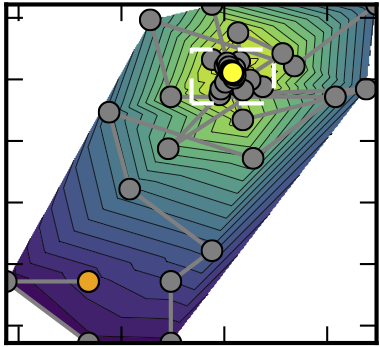
Restless tuneup of qubit gates
We have recently developed an automated gate tuneup protocol that dispenses with all qubit initialization steps. Restless tuneup exploits the real-time correlation between back-to-back non-demolition (QND) measurements in a cost function derived from randomized benchamarking to numerically optimize single-qubit gates with an order of magnitude speedup. Restless achieves 0.999 average Clifford fidelity in one minute and completely hands off! We invite you to read our manuscript here.
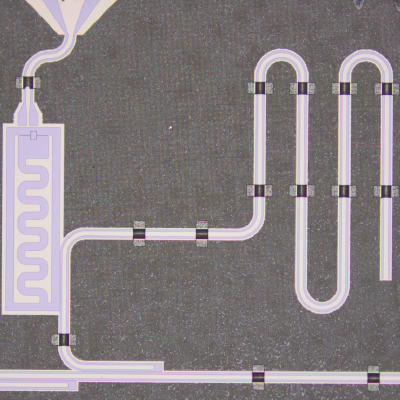
Getting rid of those leftover measurement photons
Quantum processors based on circuit QED can require a significant wait time after measurement to allow leftover photons to exit the readout resonators. We have just demonstrated two active photon depletion methods that minimize deadtime even when the resonator is driven nonlinearly to maximize readout fidelity. This speedup reduces the buildup of errors in a quantum error correction cycle. We invite you to read our manuscript.
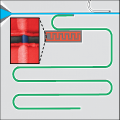
Hybrid transmon-like circuits using SNS junctions
We have realized quantum microwave circuits using proximitized InAs nanowires as Josephson elements, replacing the ubiquitous Al/AlOx/Al SIS junctions. These SNS Josephson elements can be tuned electrically: a voltage applied on a nearby gate affects the carrier density in the nanowire, which in turn changes the Josephson energy. The transition frequencies in these circuits reveal signatures of non-sinusoidal current-phase relations, offering interesting applications. Using NbTiN as the contacting superconductor also makes these circuits potentially compatible with magnetic field. We invite you to read our paper, twin paper from Charlie Marcus’ group, and an excellent Viewpoint article written about them both.

Increasing the single-photon relaxation time in planar resonators by optimization of interfaces
Coplanar waveguide resonators are crucial elements in quantum integrated circuits based on circuit QED, as well as in photodetectors, parametric amplifiers, and hybrid systems. We have recently investigated two fabrication techniques (substrate surface treatment and deep reactive ion etching) to improve or displace interfaces where dissipation-inducing two-level systems lie. Our niobium titanium nitride resonators on silicon reach internal Q’s above 1 million in the quantum regime (low temperature and single-photon operation). We are now exploring the application of these techniques to the fabrication of superconducting qubits. We invite you read out manuscript recently posted on the arXiv.
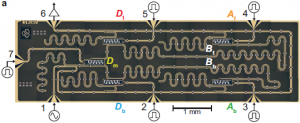
Detecting bit-flip errors in a logical qubit
We have implemented the quantum error detection step of the textbook three-qubit repetition code, using ancilla-based parity measurements in the five-qubit quantum processor shown to the right. Two, two-qubit parity measurements performed in parallel can discretize and signal bit-flip errors on the three qubits used to encode a logical qubit in GHZ-type states. Importantly, this signalling happens without decoding the information, meeting a necessary condition for fault-tolerant quantum computing. We invite you to check out our manuscript on the arXiv.
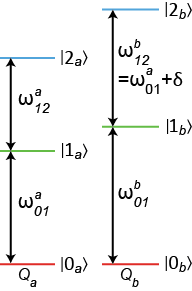
Wah-Wah single-qubit control
Transmon qubits are weakly anharmonic oscillators. Packing more of them into the 4-8 GHz band typical of cQED processors presents a challenge: how to drive the logical transition (0-1) of a targeted transmon (Qa) without driving the leakage transition (1-2) of its nearest neighbor higher up in frequency (Qb)? The Wilhelm group has recently proposed Wah-Wah pulsing for this purpose. We have now implemented Wah-Wah control in a 2D processor operating at unity crosstalk: control pulses for all qubits are applied via one feedline coupling equally to all transmons. We show that Wah-Wah successfully avoids leakage in the unaddressed transmon at gate times where conventional DRAG pulsing cannot cope. We invite you to check out our manuscript on the arXiv!
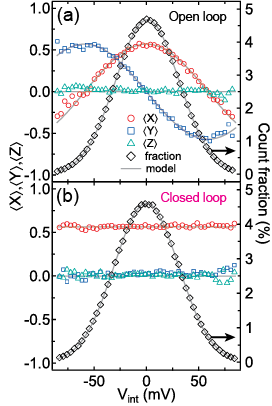
Reversing quantum trajectories with analog feedback
We have implemented an analog feedback scheme for qubit control to undo the backaction of dispersive measurement in real time. By correlating the homodyne measurement record with individual qubit trajectories, we are able to revert the stochastic phase imparted on the qubit, thus suppressing the measurement-induced dephasing. This type of analog feedback, combined with improved quantum efficiency, will be the basis of measurement-based protocols such as qubit-state stabilization and continuous-time error correction. We invite you to check out our manuscript on the arXiv!
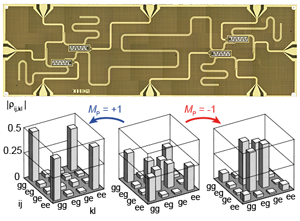
Ancilla-based parity measurement on a 2D quantum processor
Continuing our developmnet of ancilla-based indirect measurements, we have implemented a two-qubit parity meter on a versatile four-transmon processor. Our parity measurement occurs in two discrete steps: First, using unitary control, we associate the state of the ancilla qubit with data-qubit states of definite parity. Second, a high-fidelity projective measurement of the ancilla completes the protocol without dephasing the data qubits. We believe that this approach – combined with fabrication developments enabling more complex on-chip connectivity – is the way forward to error-correcting quantum circuits. Check out the details in our manuscript and stay tuned for more!
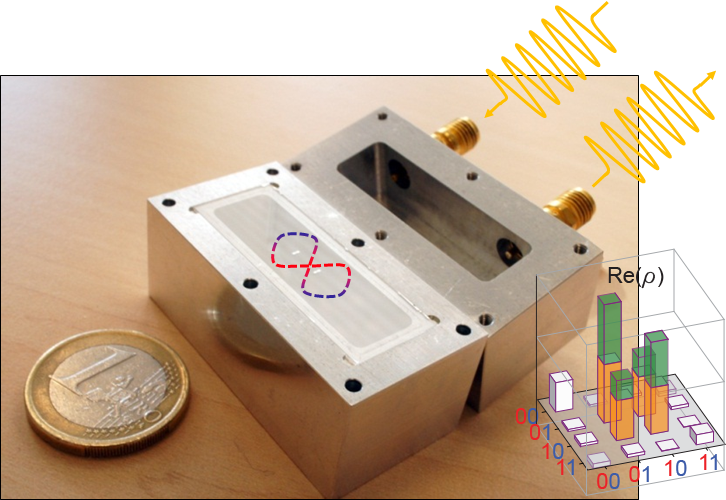
Deterministic 2-qubit entanglement by parity measurement and feedback
We have realized a high-fidelity parity measurement of two superconducting qubits using the cavity in a 3D circuit QED architecture. This parity measurement generates entanglement between two non-interacting qubits starting from a maximal superposition state. Although the projection to even or odd parity is probabilistic, using a digital feedback loop we can target the same odd-parity Bell state every time! Parity measurements and parity-conditioned qubit control as here developed are key ingredients for active error correction in quantum computing. We invite you to check out our Nature article for all experimental details and to browse the fun press coverage!
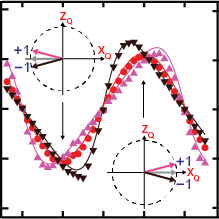
Ancilla-based indirect qubit measurement
We have realized the indirect measurement of a transmon using another transmon as ancillary qubit. This is a two-step scheme where the qubit and ancilla first interact and the ancilla is then measured with a dedicated readout resonator in a 2D circuit QED architecture. We exercise full control over the interaction and the ancilla measurement basis to investigate the tradeoff between information gain and imposed disturbance on the qubit. Combining partial and projective measurements, we observe non-classical weak values and the corresponding violations of Leggett-Garg inequalities. We invite you to check out our manuscript for all the details!

Quasiparticle tunneling and induced decoherence in transmons
Building on our work on high-fidelity readout and feedback control, we have just transformed a transmon qubit into a charge-parity detector with 6 microsecond resolution. Using this detector, we perform the first real-time observation of quasiparticle tunneling across the transmon Josephson junction, and investigate the contribution of this tunneling to qubit relaxation and pure dephasing. The observed millisecond timescale shows that this process does not currently bottleneck qubit coherence. As far as quasiparticles are concerned, the coast seems clear for another order of magnitude in coherence! You can find all details in our manuscript. Research done in collaboration with the Lehnert Lab at JILA-NIST, University of Colorado.
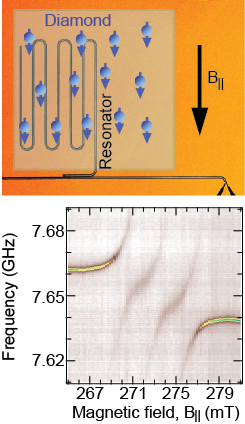
Hybrid superconductor/spin systems for quantum computing
We have just finished an in-depth study of spin dynamics in a P1-center ensemble in diamond using a superconducting resonator as a sensitive probe. A key feature in this work is that the resonator, patterned from a thin film of the highly-disordered superconductor NbTiN, can withstand in-plane magnetic field (~300 mT) needed to significantly polarize the P1 ensemble at 250 mK. We characterize the resonator-mode and temperature dependence of unprecedentedly strong coherent coupling of hyperfine-split sub-ensembles to the resonator, and perform measurements of spin linewidth, diffusion, and cross-relaxation. We believe P1-center ensembles have potential to realize a useful quantum memory for superconducting qubit circuits. We invite you to check out our manuscript. This research is done in collaboration with the Hanson and Klapwijk groups at TU Delft.
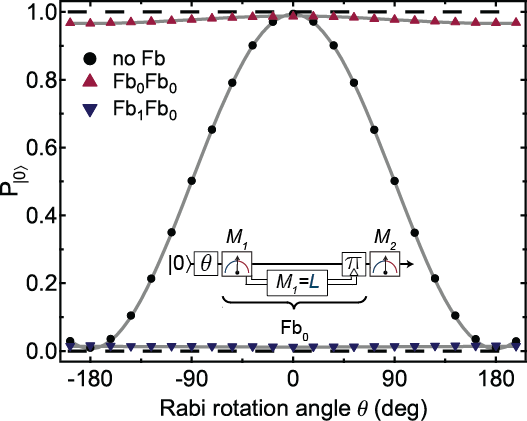
Feedback control of superconducting qubits
We have just realized digital feedback control of a superconducting qubit. That is, coherent control on the qubit that is conditioned in real time on the result of projective measurement. We use feedback to reset any qubit state on demand and fast compared to the qubit lifetime. This type of control will be at the heart of innovative measurement-based protocols in the solid state, such as quantum error correction and teleportation. Details available in our manuscript. This research is done in collaboration with theLehnert Lab at JILA-NIST, University of Colorado

High-fidelity readout of superconducting qubits
We have recently implemented a high-fidelity quantum nondemolition readout of 3D transmon qubits by boosting the sensitivity of linear dispersive readout with a Josephson parametric amplifier. We now routinely use this readout scheme to purify a two-qubit device from residual steady-state excitation, enhancing ground-state initialization by measurement and postselection. The nondemolition character of this readout will make it ideal for measurement-based quantum information protocols.
We invite you to check out our manuscript.